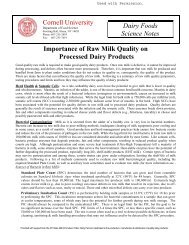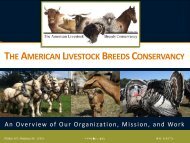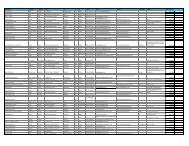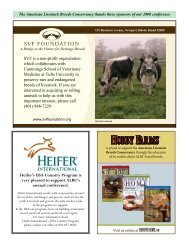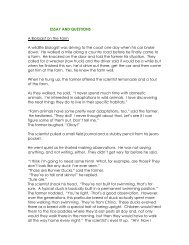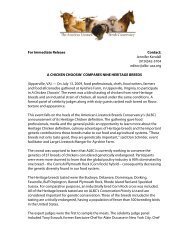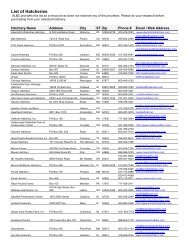Introduction to Rare Meat Rabbit Breeds - American Livestock ...
Introduction to Rare Meat Rabbit Breeds - American Livestock ...
Introduction to Rare Meat Rabbit Breeds - American Livestock ...
- No tags were found...
You also want an ePaper? Increase the reach of your titles
YUMPU automatically turns print PDFs into web optimized ePapers that Google loves.
Domestic <strong>Rabbit</strong>s in Brief• Origin• <strong>Breeds</strong>• ARBA• Standard-bred <strong>Rabbit</strong>s• Trends
8 <strong>Rare</strong> & Wonderful <strong>Breeds</strong>• <strong>American</strong>• <strong>American</strong> Chinchilla• Silver Fox• Blanc de Ho<strong>to</strong>t• Beveren• Crème D’Argent• Giant Chinchilla• Lilac
Breed Hay Day1850 1860 1870 1890 1900 1910 1920 1930 1940 1950 1960 1970 1980 1990 2000<strong>American</strong><strong>American</strong> ChinchillaSilver FoxBlanc De Ho<strong>to</strong>tBeverenCrème d’ArgentGiant ChinchillaLilac
How <strong>Rare</strong> are They?BreedTotal Shown % of Total<strong>American</strong> 48 0.60%<strong>American</strong> Chinchilla 19 0.24%Silver Fox 67 0.84%Blanc de Ho<strong>to</strong>t 26 0.27%Beveren 10 0.13%Crème D’Argent 15 0.19%Giant Chinchilla 19 0.24%Lilac 39 0.49%
Body Types
The <strong>American</strong> wasoriginally recognizedas the German BlueVienna in 1918, butwas later renamed the<strong>American</strong> Blue <strong>Rabbit</strong>because ofcircumstancessurrounding WorldWar I.<strong>American</strong>
<strong>American</strong> His<strong>to</strong>ry• Recognized by the ARBA in 1918 as the German BlueVienna• Name changed following World War II• Introduced by Lewis H. Salisbury• Breeding was kept secret, but believe Flemish Giantswere used• White variety accepted in 1925• Popular until the 1950’s for their fur and meat• Pelts were highly sought after for the richly colored pelts• One of the rarest breeds in the US
<strong>American</strong> FactsStatusOriginVarietiesBody TypeSizeCharacteristicsUniquenessCriticalGermanBlue, WhiteMandolinBucks: 9 <strong>to</strong> 11 poundsDoes: 10 <strong>to</strong> 12 poundsHardy, docile, large littersDeepest blue of all breeds
<strong>American</strong> ChinchillaThe Chinchilla rabbithas contributed <strong>to</strong> thedevelopment of morebreeds and varietiesof rabbit worldwidethan any other breedof domestic rabbit.
<strong>American</strong> Chinchilla His<strong>to</strong>ry• Developed by French engineer M.J. Dybowski and first shown inFrance in 1913• World-wide popularity as an ideal fur rabbit• First imported in<strong>to</strong> England by Haidee Lacy-Hulbert• Arrived in the US at the New York State Fair in 1919• Edward H. Stahl and Jack Harris perfected the US standard for thebreed• The <strong>American</strong> Chinchilla was born in the 1920s using StandardChinchillas for body and pelt size• Formerly called the <strong>American</strong> Heavyweight Chinchilla• Record 17,328 registered between November, 1928 and November1929• Contribution <strong>to</strong> other breeds and varieties substantial
<strong>American</strong> Chinchilla FactsStatusOriginVarietiesBody TypeSizeCharacteristicsUniquenessCriticalFrance/USAStandardCommercialBucks: 9 <strong>to</strong> 11 poundsDoes: 10 <strong>to</strong> 12 poundsHardy, gentle, good mothers,large litters, reach marketweight quickly.4-layer hair shaft color
Silver Fox – The “Teddy Bear”• Silver Fox rabbits are"Gently Giants“ andlove attention. Bigand blocky, it is hard<strong>to</strong> keep your hands offthem. They easilyadapt <strong>to</strong> any climateand sudden changesin temperature doesnot appear <strong>to</strong> botherthem.
Silver Fox His<strong>to</strong>ry• Third breed developed in the United States• Developed by Walter B. Garland of North Can<strong>to</strong>n, Ohio• Standard approved in 1925 as the <strong>American</strong> HeavyweightSilver• Recognized in Blue and Black varieties since inception• Detrimental drop in popularity in 1970s• Background unknown, Checkered Giants and ChampagneD’Argents probably, <strong>American</strong> Blue <strong>to</strong> improve meat andpelt• Only breed recognized with a standing coat
Silver Fox FactsStatusOriginVarietiesBody TypeSizeCharacteristicsUniquenessCriticalUSAStandardCommercialBucks: 9 <strong>to</strong> 11 poundsDoes: 10 <strong>to</strong> 12 poundsHardy, gentle, excellentmothers, large litters, 65%dress out ratioStanding fur coats
The Blanc de Ho<strong>to</strong>tnearly went extinctduring World War IIbut was rescued in1978 when the lateBob Whitmanimported eight . Itwas accepted by the<strong>American</strong> <strong>Rabbit</strong>Breeders Associationin 1979.Blanc de Ho<strong>to</strong>t
Blanc de Ho<strong>to</strong>t His<strong>to</strong>ry• Second breed in his<strong>to</strong>ry <strong>to</strong> be developed by women in the Ho<strong>to</strong>-en-Auge region of France• Madame Eugenie Bernhard, chatelaine du Calvados aimed for prizedfor meat and fur• Began crossing the Geant Papillon Francais in 1902• 500 breedings later, she had what is now known as Blanc de Ho<strong>to</strong>t• First arrived in the US 1921-1922 but did not gain popularity• Nearly extinct due <strong>to</strong> WWII• Bob Whitman imported 8 in<strong>to</strong> the US in 1978• Crossed with BEW Beverens, NZWs, and White Satins <strong>to</strong> widen genepool and improve body type• Accepted in<strong>to</strong> the ARBA in 1979
Blanc de Ho<strong>to</strong>t FactsStatusOriginVarietiesBody TypeSizeCharacteristicsUniquenessThreatenedFranceStandardCommercialBucks: 8 <strong>to</strong> 10 poundsDoes: 9 <strong>to</strong> 11 poundsActive, hardy, goodmothersEye bands
Beveren – “Peace”The Beveren is said <strong>to</strong> bethe origin of the“peace” sign. Assoldiers walkedjubilantly through thecountry near the endof WWII, they cameupon some Beverenthat carry their earsin a “V”. The rest ishis<strong>to</strong>ry.
Beveren His<strong>to</strong>ry• One of oldest and rarest breeds of fur rabbit• Named after <strong>to</strong>wn of same name in Western Belgium• Recognized in 1898• Blue Beverens imported in<strong>to</strong> England by Mrs. A.M.Martin in 1905• Beveren Club founded there in 1918• Popularity as most popular fur breed sky-rocketed• Standard and Giant Beverens arrived in US in 1915• Several blue breeds already in the US at this time• Edward H. Stahl imported the BEW Beveren in 1933• Recognized now in blue, black and BEW
Beveren FactsStatusOriginVarietiesBody TypeSizeCharacteristicsUniquenessWatchBelgiumStandardMandolinBucks: 8 <strong>to</strong> 11 poundsDoes: 9 <strong>to</strong> 12 poundsDocile, clean, smart,curiousFamous “v-shaped” ears
The Crème d’Argent hasbecome extinct in allcountries except theUS and the UnitedKingdom. The globalpopulation isestimated <strong>to</strong> be under1000 animals.Crème d’Argent
Crème d’Argent His<strong>to</strong>ry• Developed in France mid <strong>to</strong> late 1800s• Origin unclear, but it is the oldest of seven Argent breeds• Description appeared at exhibition near Paris in 1877• Fur became popular for trimmings• Imported in<strong>to</strong> the US by 1924 by breeders in New York• Crossed with other breeds including Golden Palomino• First shown at the Indiana Convention in 1936• Working Standard introduced in 1938• Global population is estimated at no more than 1,000animals
Crème d’Argent FactsStatusOriginVarietiesBody TypeSizeCharacteristicsUniquenessWatchFranceStandardCommercialBucks: 8 <strong>to</strong> 10.5 poundsDoes: 8.5 <strong>to</strong> 11 poundsRelaxed, reliablemothers, smaller littersColor
Edward H. Stahl,“Father of theDomestic <strong>Rabbit</strong>Industry in America”,is the first and onlyindividual <strong>to</strong> evermake a milliondollars from the saleof rabbit breedings<strong>to</strong>ck.Giant Chinchilla
Giant Chinchilla His<strong>to</strong>ry• Edward H. Stahl active in breeding of Chinchillabreeds• Incorporated NZWs, White Flemish Giants, and<strong>American</strong> Blue does• Envisioned a large breed that could offer meatand large pelt• 1921 the birth of the “Million Dollar Princess”• Recognized by the ARBA in 1928
Giant Chinchilla FactsStatusOriginVarietiesBody TypeSizeCharacteristicsWatchUSAStandardMandolinBucks: 12 <strong>to</strong> 15 poundsDoes: 13 <strong>to</strong> 16 poundsHardy, excellent mothers,large litters, reach marketsize quickly, need solid
LilacIt is the British that canclaim <strong>to</strong> haveachieved the bestcoloration for thebreed – their Lilacsare truly the pinkishdove gray called forin the breed standard.
Lilac His<strong>to</strong>ryDeveloped simultaneously in The Netherlands and England• Crossed with Blue Beverens and Havanas by famed geneticist R.C.Punnet in 1922• Both British and European varieties were brought <strong>to</strong> the US• Numerous imports 1922-1926• Popularity strong on US West Coast, spread East• Standard established unchanged from 1939 <strong>to</strong> 1944• 25 shown at 1940 National Convention• Club had become inactive by 1951• In 1952, “Mr. Lilac” Ken Fehrman, became secretary endeavoring <strong>to</strong>bring the breed back• 1973 National Convention had 31 entered by 8 exhibi<strong>to</strong>rs• 1996 National Convention had 36 shown by 10 exhibi<strong>to</strong>rs
Lilac FactsStatusOriginVarietiesBody TypeSizeCharacteristicsUniquenessWatchNetherlands/EnglandStandardCompactBucks: 5.5 <strong>to</strong> 7.5 poundsDoes: 6 <strong>to</strong> 8 poundsHardy, docile, slightlyshy, smaller littersColor
Thank youPreserving their heritagepreserves ours
Resources• The <strong>American</strong> Lives<strong>to</strong>ck <strong>Breeds</strong> Conservancy, Box 477, Pittsboro, NC 27312, (919) 542-5704, emailalbc@albc-usa.org, www.albc-usa.org• <strong>American</strong> <strong>Rabbit</strong> Breeders Association, Inc., PO Box 426, Blooming<strong>to</strong>n, IL 61702, (309) 664-7500, Fax(309) 664-0941, email ARBAPOST@aol.com, or visit www.arba.net• <strong>American</strong> Blue and White <strong>Rabbit</strong> Club, 7433 N. State Road 59, Brazil, IN 47834, (812) 448-2304,www.rabbitgeek.com/abwrc.html• <strong>American</strong> Chinchilla <strong>Rabbit</strong> Breeders Association, Crystal Krienke-Bonkoski, Secretary/Treasurer,R16827 Cherry Road, Ringle, WI 54771, email clkrienke@yahoo.com• National Silver Fox <strong>Rabbit</strong> Club, Rae Harris, Secretary/Treasurer, 4177 Olive Branch Road, Galien, MI49113 (269) 545-2534, silver_fox@hughes.net• Ho<strong>to</strong>t <strong>Rabbit</strong> Breeders International, c/o Laurie Staley-Jones, 51 S. Olive Church Rd., Paragon, IN46166, (765) 537-2432, email lazyslops@yahoo.com, or visit www.geocities.com/blancdeho<strong>to</strong>tclub/• <strong>American</strong> Beveren <strong>Rabbit</strong> Club, c/o Meg Whitehouse, 480 Colts Neck Road, Farmingdale, NJ 07727, orvisit www.beverens.8m.com• Crème d’Argent <strong>Rabbit</strong> Federation, Travis West, Secretary, 2293 Fac<strong>to</strong>ry Rd., Albany, OH 45710, (740)698-7285, cremedargent@hotmail.com, or visit www.cremedargentfederation.com/• Giant Chinchilla <strong>Rabbit</strong> Association, 4195 Country Road 115, Mt. Gilead, OH 43338, (419) 864-7936,email Miley4@bright.net• National Lilac <strong>Rabbit</strong> Club of America, Judy Bustle, 132 Farmers Lane, State Road, NC 28676, emailrogr_rabbit@msn.com or visit http://www.geocities.com/nlrca2002/



